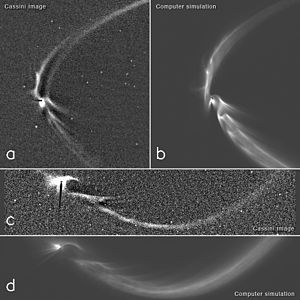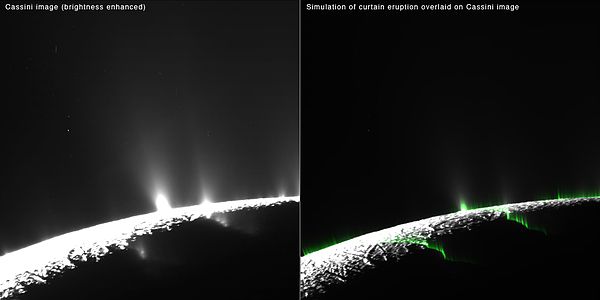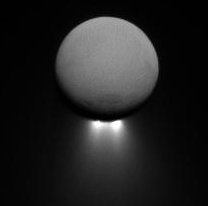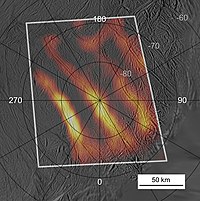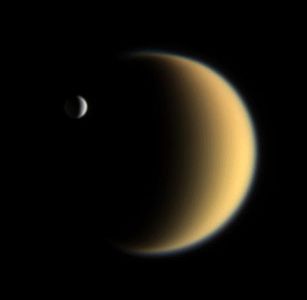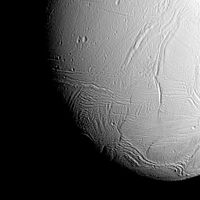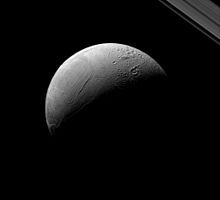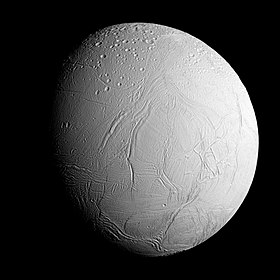
View of trailing hemisphere in natural color
| |||||||||||||
| Discovery | |||||||||||||
|---|---|---|---|---|---|---|---|---|---|---|---|---|---|
| Discovered by | William Herschel | ||||||||||||
| Discovery date | August 28, 1789 | ||||||||||||
| Designations | |||||||||||||
| Pronunciation | /ɛnˈsɛlədəs/ | ||||||||||||
| Saturn II | |||||||||||||
| Adjectives | Enceladean, Enceladan | ||||||||||||
| Orbital characteristics | |||||||||||||
| 237948 km | |||||||||||||
| Eccentricity | 0.0047 | ||||||||||||
| 1.370218 d | |||||||||||||
| Inclination | 0.019° (to Saturn's equator) | ||||||||||||
| Satellite of | Saturn | ||||||||||||
| Physical characteristics | |||||||||||||
| Dimensions | 513.2 × 502.8 × 496.6 km | ||||||||||||
Mean radius
| 252.1±0.2 km (0.0395 Earths, 0.1451 Moons) | ||||||||||||
| Mass | (1.08022±0.00101)×1020 kg (1.8×10−5 Earths) | ||||||||||||
Mean density
| 1.609±0.005 g/cm3 | ||||||||||||
| 0.113 m/s2 (0.0113 g) | |||||||||||||
| ~0.335 (estimate) | |||||||||||||
| 0.239 km/s (860.4 km/h) | |||||||||||||
| Synchronous | |||||||||||||
| Zero | |||||||||||||
| Albedo | 1.375±0.008 (geometric at 550 nm) or 0.81±0.04 (Bond) | ||||||||||||
| |||||||||||||
| 11.7 | |||||||||||||
| Atmosphere | |||||||||||||
Surface pressure
| Trace, significant spatial variability | ||||||||||||
| Composition by volume | 91% water vapor 4% nitrogen 3.2% carbon dioxide 1.7% methane | ||||||||||||
Enceladus (/ɛnˈsɛlədəs/; en-SEL-ə-dəs) is the sixth-largest moon of Saturn. It is about 500 kilometers (310 mi) in diameter, about a tenth of that of Saturn's largest moon, Titan. Enceladus is mostly covered by fresh, clean ice, making it one of the most reflective bodies of the Solar System. Consequently, its surface temperature at noon only reaches −198 °C (−324 °F), far colder than a light-absorbing body would be. Despite its small size, Enceladus has a wide range of surface features, ranging from old, heavily cratered regions to young, tectonically deformed terrains.
Enceladus was discovered on August 28, 1789, by William Herschel, but little was known about it until the two Voyager spacecraft, Voyager 1 and Voyager 2, passed nearby in the early 1980s. In 2005, the Cassini spacecraft started multiple close flybys of Enceladus, revealing its surface and environment in greater detail. In particular, Cassini discovered water-rich plumes venting from the south polar region. Cryovolcanoes near the south pole shoot geyser-like jets of water vapor, molecular hydrogen, other volatiles, and solid material, including sodium chloride crystals and ice particles, into space, totaling about 200 kg (440 lb) per second. Over 100 geysers have been identified. Some of the water vapor falls back as "snow"; the rest escapes, and supplies most of the material making up Saturn's E ring. According to NASA scientists, the plumes are similar in composition to comets. In 2014, NASA reported that Cassini found evidence for a large south polar subsurface ocean of liquid water with a thickness of around 10 km (6 mi).
These geyser observations, along with the finding of escaping internal heat and very few (if any) impact craters in the south polar region, show that Enceladus is currently geologically active. Like many other satellites in the extensive systems of the giant planets, Enceladus is trapped in an orbital resonance. Its resonance with Dione excites its orbital eccentricity, which is damped by tidal forces, tidally heating its interior and driving the geological activity.
On 27 June 2018, scientists reported the detection of complex macromolecular organics on Enceladus' jet plumes, as sampled by the Cassini orbiter.
History
Discovery
Voyager 2 view of Enceladus in 1981: Samarkand Sulci vertical grooves (lower center); Ali Baba and Aladdin craters (upper left)
Enceladus was discovered by William Herschel on August 28, 1789, during the first use of his new 1.2 m (47 in) telescope, then the largest in the world. Its faint apparent magnitude (HV
= +11.7) and its proximity to the much brighter Saturn and Saturn's
rings make Enceladus difficult to observe from Earth with smaller
telescopes. Like many satellites of Saturn discovered prior to the Space Age,
Enceladus was first observed during a Saturnian equinox, when Earth is
within the ring plane. At such times, the reduction in glare from the
rings makes the moons easier to observe. Prior to the Voyager missions
the view of Enceladus improved little from the dot first observed by
Herschel. Only its orbital characteristics were known, with estimations
of its mass, density and albedo.
Naming
Enceladus is named after the giant Enceladus of Greek mythology.
The name, like the names of each of the first seven satellites of
Saturn to be discovered, was suggested by William Herschel's son John Herschel in his 1847 publication Results of Astronomical Observations made at the Cape of Good Hope. He chose these names because Saturn, known in Greek mythology as Cronus, was the leader of the Titans.
Features on Enceladus are named by the International Astronomical Union (IAU) after characters and places from Burton's translation of The Book of One Thousand and One Nights. Impact craters are named after characters, whereas other feature types, such as fossae (long, narrow depressions), dorsa (ridges), planitiae (plains), sulci (long parallel grooves), and rupes
(cliffs) are named after places. The IAU has officially named 85
features on Enceladus, most recently Samaria Rupes, formerly called
Samaria Fossa.
Orbit and rotation
View of Enceladus's orbit (highlighted in red) from above Saturn's north pole
Enceladus is one of the major inner satellites of Saturn along with Dione, Tethys, and Mimas.
It orbits at 238,000 km from Saturn's center and 180,000 km from its
cloud tops, between the orbits of Mimas and Tethys. It orbits Saturn
every 32.9 hours, fast enough for its motion to be observed over a
single night of observation. Enceladus is currently in a 2:1 mean-motion
orbital resonance
with Dione, completing two orbits around Saturn for every one orbit
completed by Dione. This resonance maintains Enceladus's orbital
eccentricity (0.0047), which is known as a forced eccentricity. This
non-zero eccentricity results in tidal deformation of Enceladus. The
dissipated heat resulting from this deformation is the main heating
source for Enceladus's geologic activity. Enceladus orbits within the densest part of Saturn's E ring, the outermost of its major rings, and is the main source of the ring's material composition.
Like most of Saturn's larger satellites, Enceladus rotates
synchronously with its orbital period, keeping one face pointed toward
Saturn. Unlike Earth's Moon, Enceladus does not appear to librate
more than 1.5° about its spin axis. However, analysis of the shape of
Enceladus suggests that at some point it was in a 1:4 forced secondary
spin–orbit libration. This libration could have provided Enceladus with an additional heat source.
Source of the E ring
Plumes from Enceladus, which are similar in composition to comets, have been shown to be the source of the material in Saturn's E ring. The E ring is the widest and outermost ring of Saturn (except for the tenuous Phoebe ring). It is an extremely wide but diffuse disk of microscopic icy or dusty material distributed between the orbits of Mimas and Titan.
Mathematical models show that the E ring is unstable, with a
lifespan between 10,000 and 1,000,000 years; therefore, particles
composing it must be constantly replenished.
Enceladus is orbiting inside the ring, at its narrowest but highest
density point. In the 1980s some suspected that Enceladus is the main
source of particles for the ring. This hypothesis was confirmed by Cassini's first two close flybys in 2005.
Eruptions on Enceladus look like "discrete" jets, but may be "curtain" eruptions instead
Geology
Surface features
South polar vantage of Enceladus's anti-Saturn hemisphere, using a false color scheme in which fractured areas show up as blue
Enceladus – tilted terminator – north is up
Voyager 2
was the first spacecraft to observe Enceladus's surface in detail, in
August 1981. Examination of the resulting highest-resolution imagery
revealed at least five different types of terrain, including several
regions of cratered terrain, regions of smooth (young) terrain, and
lanes of ridged terrain often bordering the smooth areas. In addition, extensive linear cracks and scarps
were observed. Given the relative lack of craters on the smooth plains,
these regions are probably less than a few hundred million years old.
Accordingly, Enceladus must have been recently active with "water volcanism" or other processes that renew the surface.
The fresh, clean ice that dominates its surface gives Enceladus the
most reflective surface of any body in the Solar System, with a visual geometric albedo of 1.38 and bolometric Bond albedo of 0.81±0.04.
Because it reflects so much sunlight, its surface only reaches a mean
noon temperature of −198 °C (−324 °F), somewhat colder than other
Saturnian satellites.
Observations during three flybys by Cassini on February 17, March 9, and July 14, 2005, revealed Enceladus' surface features in much greater detail than the Voyager 2 observations. The smooth plains, which Voyager 2 had observed, resolved into relatively crater-free regions filled with numerous small ridges
and scarps. Numerous fractures were found within the older, cratered
terrain, suggesting that the surface has been subjected to extensive
deformation since the craters were formed.
Some areas contain no craters, indicating major resurfacing events in
the geologically recent past. There are fissures, plains, corrugated
terrain and other crustal deformations. Several additional regions of
young terrain were discovered in areas not well-imaged by either Voyager spacecraft, such as the bizarre terrain near the south pole. All of this indicates that Enceladus's interior may be liquid today, even though it should have been frozen long ago.
A Cassini
mosaic of degraded craters, fractures, and disrupted terrain in
Enceladus's north polar region. The two prominent craters above the
middle terminator are Ali Baba (upper) and Aladdin. The Samarkand Sulci grooves run vertically to their left.
Enhanced-color global map from Cassini images (43.7 MB); leading hemisphere is on right
Enhanced-color maps of the trailing and leading hemispheres of Enceladus
Impact craters
Impact cratering
is a common occurrence on many Solar System bodies. Much of Enceladus'
surface is covered with craters at various densities and levels of
degradation.
This subdivision of cratered terrains on the basis of crater density
(and thus surface age) suggests that Enceladus has been resurfaced in
multiple stages.
Cassini observations provided a much closer look at the
crater distribution and size, showing that many of Enceladus' craters
are heavily degraded through viscous relaxation and fracturing.
Viscous relaxation allows gravity, over geologic time scales, to deform
craters and other topographic features formed in water ice, reducing
the amount of topography over time. The rate at which this occurs is
dependent on the temperature of the ice: warmer ice is easier to deform
than colder, stiffer ice. Viscously relaxed craters tend to have domed floors, or are recognized as craters only by a raised, circular rim. Dunyazad crater is a prime example of a viscously relaxed crater on Enceladus, with a prominent domed floor.
Tectonic features
View of Enceladus's Europa-like surface with the Labtayt Sulci fractures at center and the Ebony and Cufa dorsa at lower left, imaged by Cassini on February 17, 2005
Voyager 2 found several types of tectonic features on Enceladus, including troughs, scarps, and belts of grooves and ridges. Results from Cassini suggest that tectonics
is the dominant mode of deformation on Enceladus, including rifts, one
of the more dramatic types of tectonic features that were noted. These
canyons can be up to 200 km long, 5–10 km wide, and 1 km deep. Such
features are geologically young, because they cut across other tectonic
features and have sharp topographic relief with prominent outcrops along
the cliff faces.
Evidence of tectonics on Enceladus is also derived from grooved
terrain, consisting of lanes of curvilinear grooves and ridges. These
bands, first discovered by Voyager 2, often separate smooth plains from cratered regions. Grooved terrains such as the Samarkand Sulci are reminiscent of grooved terrain on Ganymede.
However, unlike those seen on Ganymede, grooved topography on Enceladus
is generally more complex. Rather than parallel sets of grooves, these
lanes often appear as bands of crudely aligned, chevron-shaped features.
In other areas, these bands bow upwards with fractures and ridges
running the length of the feature. Cassini observations of the
Samarkand Sulci have revealed dark spots (125 and 750 m wide) located
parallel to the narrow fractures. Currently, these spots are interpreted
as collapse pits within these ridged plain belts.
In addition to deep fractures and grooved lanes, Enceladus has
several other types of tectonic terrain. Many of these fractures are
found in bands cutting across cratered terrain. These fractures probably
propagate down only a few hundred meters into the crust. Many have
probably been influenced during their formation by the weakened regolith produced by impact craters, often changing the strike of the propagating fracture. Another example of tectonic features on Enceladus are the linear grooves first found by Voyager 2 and seen at a much higher resolution by Cassini.
These linear grooves can be seen cutting across other terrain types,
like the groove and ridge belts. Like the deep rifts, they are among the
youngest features on Enceladus. However, some linear grooves have been
softened like the craters nearby, suggesting that they are older. Ridges
have also been observed on Enceladus, though not nearly to the extent
as those seen on Europa.
These ridges are relatively limited in extent and are up to one
kilometer tall. One-kilometer high domes have also been observed.
Given the level of resurfacing found on Enceladus, it is clear that
tectonic movement has been an important driver of geology for much of
its history.
Smooth plains
Two regions of smooth plains were observed by Voyager 2.
They generally have low relief and have far fewer craters than in the
cratered terrains, indicating a relatively young surface age. In one of the smooth plain regions, Sarandib Planitia,
no impact craters were visible down to the limit of resolution. Another
region of smooth plains to the southwest of Sarandib is criss-crossed
by several troughs and scarps. Cassini has since viewed these smooth plains regions, like Sarandib Planitia and Diyar Planitia at much higher resolution. Cassini images show these regions filled with low-relief ridges and fractures, probably caused by shear deformation.
The high-resolution images of Sarandib Planitia revealed a number of
small impact craters, which allow for an estimate of the surface age,
either 170 million years or 3.7 billion years, depending on assumed impactor population.
The expanded surface coverage provided by Cassini has
allowed for the identification of additional regions of smooth plains,
particularly on Enceladus's leading hemisphere (the side of Enceladus
that faces the direction of motion as it orbits Saturn). Rather than
being covered in low-relief ridges, this region is covered in numerous
criss-crossing sets of troughs and ridges, similar to the deformation
seen in the south polar region. This area is on the opposite side of
Enceladus from Sarandib and Diyar Planitiae, suggesting that the
placement of these regions is influenced by Saturn's tides on Enceladus.
South polar region
Close-up of south pole terrain
Images taken by Cassini during the flyby on July 14, 2005,
revealed a distinctive, tectonically deformed region surrounding
Enceladus's south pole. This area, reaching as far north as 60° south
latitude, is covered in tectonic fractures and ridges.
The area has few sizable impact craters, suggesting that it is the
youngest surface on Enceladus and on any of the mid-sized icy
satellites; modeling of the cratering rate suggests that some regions of
the south polar terrain are possibly as young as 500,000 years or less. Near the center of this terrain are four fractures bounded by ridges, unofficially called "tiger stripes".
They appear to be the youngest features in this region and are
surrounded by mint-green-colored (in false color, UV–green–near IR
images), coarse-grained water ice, seen elsewhere on the surface within
outcrops and fracture walls.
Here the "blue" ice is on a flat surface, indicating that the region is
young enough not to have been coated by fine-grained water ice from the
E ring.
Results from the visual and infrared spectrometer (VIMS) instrument
suggest that the green-colored material surrounding the tiger stripes is
chemically distinct from the rest of the surface of Enceladus. VIMS
detected crystalline water ice in the stripes, suggesting that they are
quite young (likely less than 1,000 years old) or the surface ice has
been thermally altered in the recent past.
VIMS also detected simple organic (carbon-containing) compounds in the
tiger stripes, chemistry not found anywhere else on Enceladus thus far. And in 27 June 2018, scientists reported the detection of complex macromolecular organics on Enceladus' jet plumes, as sampled by the Cassini orbiter.
One of these areas of "blue" ice in the south polar region was
observed at high resolution during the July 14, 2005 flyby, revealing an
area of extreme tectonic deformation and blocky terrain, with some
areas covered in boulders 10–100 m across.
Y-shaped discontinuities, imaged February 15, 2016
The boundary of the south polar region is marked by a pattern of
parallel, Y- and V-shaped ridges and valleys. The shape, orientation,
and location of these features suggest they are caused by changes in the
overall shape of Enceladus. As of 2006 there were two theories for what
could cause such a shift in shape: the orbit of Enceladus may have
migrated inward, leading to an increase in Enceladus's rotation rate.
Such a shift would lead to a more oblate shape;
or a rising mass of warm, low-density material in Enceladus's interior
may have led to a shift in the position of the current south polar
terrain from Enceladus's southern mid-latitudes to its south pole.
Consequently, the moon's ellipsoid shape would have adjusted to match
the new orientation. One problem of the polar flattening hypothesis is
that both polar regions should have similar tectonic deformation
histories. However, the north polar region is densely cratered, and has a much older surface age than the south pole. Thickness variations in Enceladus's lithosphere
is one explanation for this discrepancy. Variations in lithospheric
thickness are supported by the correlation between the Y-shaped
discontinuities and the V-shaped cusps along the south polar terrain
margin and the relative surface age of the adjacent non-south polar
terrain regions. The Y-shaped discontinuities, and the north-south
trending tension fractures into which they lead, are correlated with
younger terrain with presumably thinner lithospheres. The V-shaped cusps
are adjacent to older, more heavily cratered terrains.
Internal structure
A model of the interior of Enceladus: silicate core (brown); water-ice-rich mantle (white); a proposed diapir under the south pole (noted in the mantle (yellow) and core (red))
Before the Cassini mission, little was known about the interior of Enceladus. However, flybys by Cassini
provided information for models of Enceladus's interior, including a
better determination of the mass and shape, high-resolution observations
of the surface, and new insights on the interior.
Mass estimates from the Voyager program missions suggested that Enceladus was composed almost entirely of water ice. However, based on the effects of Enceladus's gravity on Cassini, its mass was determined to be much higher than previously thought, yielding a density of 1.61 g/cm3.
This density is higher than Saturn's other mid-sized icy satellites,
indicating that Enceladus contains a greater percentage of silicates and iron.
Castillo et al. (2005) suggested that Iapetus
and the other icy satellites of Saturn formed relatively quickly after
the formation of the Saturnian subnebula, and thus were rich in
short-lived radionuclides. These radionuclides, like aluminium-26 and iron-60,
have short half-lives and would produce interior heating relatively
quickly. Without the short-lived variety, Enceladus's complement of
long-lived radionuclides would not have been enough to prevent rapid
freezing of the interior, even with Enceladus's comparatively high
rock–mass fraction, given its small size. Given Enceladus's relatively high rock–mass fraction, the proposed enhancement in 26Al and 60Fe would result in a differentiated body, with an icy mantle and a rocky core. Subsequent radioactive and tidal
heating would raise the temperature of the core to 1,000 K, enough to
melt the inner mantle. However, for Enceladus to still be active, part
of the core must have also melted, forming magma chambers that would flex under the strain of Saturn's tides. Tidal heating, such as from the resonance with Dione or from libration, would then have sustained these hot spots in the core and would power the current geological activity.
In addition to its mass and modeled geochemistry,
researchers have also examined Enceladus's shape to determine if it is
differentiated. Porco et al. (2006) used limb measurements to determine
that its shape, assuming hydrostatic equilibrium, is consistent with an undifferentiated interior, in contradiction to the geological and geochemical evidence.
However, the current shape also supports the possibility that Enceladus
is not in hydrostatic equilibrium, and may have rotated faster at some
point in the recent past (with a differentiated interior). Gravity measurements by Cassini show that the density of the core is low, indicating that the core contains water in addition to silicates.
Subsurface water ocean
Artist's impression of possible hydrothermal activity on Enceladus's ocean floor
Artist's impression of a global subsurface ocean of liquid water (updated and better scaled version)
Evidence of liquid water on Enceladus began to accumulate in 2005,
when scientists observed plumes containing water vapor spewing from its
south polar surface, with jets moving 250 kg of water vapor every second at up to 2,189 km/h (1,360 mph) into space. Soon after, in 2006 it was determined that Enceladus's plumes are the source of Saturn's E Ring. The sources of salty particles are uniformly distributed along the tiger stripes,
whereas sources of "fresh" particles are closely related to the
high-speed gas jets. The "salty" particles are heavier and mostly fall
back to the surface, whereas the fast "fresh" particles escape to the E
ring, explaining its salt-poor composition of 0.5–2% of sodium salts by
mass. The plumes' "salty" composition indicates that the source is a salty subsurface ocean. Cassini also found traces of simple organic compounds in some dust grains, as well as organics such as benzene (C
6H
6), and complex macromolecular organics as large as 200 atomic mass units, and at least 15 carbon atoms in size.
6H
6), and complex macromolecular organics as large as 200 atomic mass units, and at least 15 carbon atoms in size.
Gravimetric data from Cassini's December 2010 flybys
showed that Enceladus likely has a liquid water ocean beneath its frozen
surface, but at the time it was thought the subsurface ocean was
limited to the south pole.
The top of the ocean probably lies beneath a 30 to 40 kilometers (19 to
25 mi) thick ice shelf. The ocean may be 10 kilometers (6.2 mi) deep at
the south pole.
Measurements of Enceladus's "wobble" as it orbits Saturn—called libration—suggests
that the entire icy crust is detached from the rocky core and therefore
that a global ocean is present beneath the surface. The amount of libration (0.120° ± 0.014°) implies that this global ocean is about 26 to 31 kilometers (16-19 mi) deep. For comparison, Earth's ocean has an average depth of 3.7 kilometers.
A model suggests that Enceladus's salty ocean (-Na, -Cl, -CO3) has an alkaline pH of 11 to 12. The high pH is interpreted to be a consequence of serpentinization of chondritic rock that leads to the generation of H2,
a geochemical source of energy that can support both abiotic and
biological synthesis of organic molecules such as those that have been
detected in Enceladus's plumes.
South polar plumes
One possible scheme for Enceladus's cryovolcanism
Following Voyager's encounters with Enceladus in the early
1980s, scientists postulated that it may be geologically active based on
its young, reflective surface and location near the core of the E ring.
Based on the connection between Enceladus and the E ring, scientists
suspected that Enceladus was the source of material in the E ring,
perhaps through venting of water vapor. Readings from Cassini's 2005 passage suggested that cryovolcanism,
where water and other volatiles are the materials erupted instead of
silicate rock, had been discovered on Enceladus. The first Cassini
sighting of a plume of icy particles above Enceladus's south pole came
from the Imaging Science Subsystem (ISS) images taken in January and
February 2005, though the possibility of a camera artifact delayed an official announcement. Data from the magnetometer
instrument during the February 17, 2005, encounter provided a hint that
the feature might be real when it found evidence for a planetary
atmosphere. The magnetometer observed an increase in the power of ion cyclotron waves
near Enceladus. These waves are produced by the interaction of ionized
particles and magnetic fields, and the waves' frequency can be used to
identify their composition, in this case ionized water vapor. During the two following encounters, the magnetometer
team determined that gases in Enceladus's atmosphere are concentrated
over the south polar region, with atmospheric density away from the pole
being much lower. The Ultraviolet Imaging Spectrograph (UVIS) confirmed this result by observing two stellar occultations
during the February 17 and July 14 encounters. Unlike the magnetometer,
UVIS failed to detect an atmosphere above Enceladus during the February
encounter when it looked over the equatorial region, but did detect
water vapor during an occultation over the south polar region during the
July encounter.
Chemical composition of Enceladus's plumes
Fortuitously, Cassini flew through this gas cloud during the July 14 encounter, allowing instruments such as the ion and neutral mass spectrometer (INMS)
and the cosmic dust analyzer (CDA) to directly sample the plume. INMS
measured the composition of the gas cloud, detecting mostly water vapor, as well as traces of molecular nitrogen, methane, and carbon dioxide.
The CDA "detected a large increase in the number of particles near
Enceladus", confirming Enceladus as the primary source for the E ring. Analysis of the CDA and INMS data suggest that the gas cloud Cassini
flew through during the July encounter, and observed from a distance
with its magnetometer and UVIS, was actually a water-rich cryovolcanic
plume, originating from vents near the south pole.
Possible origins of methane found in plumes
Visual confirmation of venting came in November 2005, when ISS imaged geyser-like jets of icy particles rising from Enceladus's south polar region.
(Although the plume was imaged before, in January and February 2005,
additional studies of the camera's response at high phase angles, when
the Sun is almost behind Enceladus, and comparison with equivalent
high-phase-angle images taken of other Saturnian satellites, were
required before this could be confirmed.)
The November 2005 images showed the plume's fine structure, revealing
numerous jets (perhaps issuing from numerous distinct vents) within a
larger, faint component extending out nearly 500 km from the surface. The particles have a bulk velocity of 1.25 ±0.1 km/s, and a maximum velocity of 3.40 km/s. Cassini's
UVIS later observed gas jets coinciding with the dust jets seen by ISS
during a non-targeted encounter with Enceladus in October 2007.
Observations during a flyby on March 12, 2008, revealed
additional chemicals in the plume, including trace amounts of simple
hydrocarbons such as methane, propane, acetylene and formaldehyde. The plumes' composition, as measured by the INMS, is similar to that seen at most comets.
In 2015, the Cassini probe made a close fly-by of
Enceladus' south pole, flying within 48.3 km (30 mi) of the surface, and
through a plume. Its mass spectrometer detected molecular hydrogen which was in "thermodynamic disequilibrium" with the other components.
The combined analysis of imaging, mass spectrometry, and
magnetospheric data suggests that the observed south polar plume
emanates from pressurized subsurface chambers, similar to Earth's geysers. The mechanism that drives and sustains the eruptions is thought to be tidal heating.
The intensity of the eruption of the south polar jets varies
significantly as a function of the position of Enceladus in its orbit.
The plumes are about four times brighter when Enceladus is at apoapsis (the point in its orbit most distant from Saturn) than when it is at periapsis.
This is consistent with geophysical calculations which predict the
south polar fissures are under compression near periapsis, pushing them
shut, and under tension near apoapsis, pulling them open.
Much of the plume activity consists of broad curtain-like
eruptions. Optical illusions from a combination of viewing direction and
local fracture geometry previously made the plumes look like discrete
jets.
The extent to which cryovolcanism
really occurs is a subject of some debate, as water, being denser than
ice by about 8%, has difficulty erupting under normal circumstances. At
Enceladus, it appears that cryovolcanism occurs because water-filled
cracks are periodically exposed to vacuum, the cracks being opened and
closed by tidal stresses.
Possible heat sources
During
the flyby of July 14, 2005, the Composite Infrared Spectrometer (CIRS)
found a warm region near the south pole. Temperatures in this region
ranged from 85–90 K, with small areas showing as high as 157 K
(−116 °C), much too warm to be explained by solar heating, indicating
that parts of the south polar region are heated from the interior of
Enceladus. The presence of a subsurface ocean under the south polar region is now accepted, but it cannot explain the source of the heat, with an estimated heat flux of 200 mW/m2, which is about 10 times higher than that from radiogenic heating alone.
Heat map of the south polar fractures, dubbed 'tiger stripes'
Several explanations for the observed elevated temperatures and the
resulting plumes have been proposed, including venting from a subsurface
reservoir of liquid water, sublimation of ice, decompression and dissociation of clathrates, and shear heating,
but a complete explanation of all the heat sources causing the observed
thermal power output of Enceladus has not yet been settled.
Heating in Enceladus has occurred through various mechanisms ever since its formation. Radioactive decay in its core may have initially heated it,
giving it a warm core and a subsurface ocean, which is now kept above
freezing through an unidentified mechanism. Geophysical models indicate
that tidal heating is a main heat source, perhaps aided by radioactive decay and some heat-producing chemical reactions. A 2007 study predicted the internal heat of Enceladus, if generated by tidal forces, could be no greater than 1.1 gigawatts, but data from Cassini's
infrared spectrometer of the south polar terrain over 16 months,
indicate that the internal heat generated power is about 4.7 gigawatts, and suggest that it is in thermal equilibrium.
The observed power output of 4.7 gigawatts is challenging to
explain from tidal heating alone, so the main source of heat remains a
mystery.
Most scientists think the observed heat flux of Enceladus is not enough
to maintain the subsurface ocean, and therefore any subsurface ocean
must be a remnant of a period of higher eccentricity and tidal heating,
or the heat is produced through another mechanism.
Tidal heating
Tidal heating
occurs through the tidal friction processes: orbital and rotational
energy are dissipated as heat in the crust of an object. In addition, to
the extent that tides produce heat along fractures, libration may affect the magnitude and distribution of such tidal shear heating.
Tidal dissipation of Enceladus's ice crust is significant because
Enceladus has a subsurface ocean. A computer simulation that used data
from Cassini was published in November 2017, and it indicates
that friction heat from the sliding rock fragments within the permeable
and fragmented core of Enceladus could keep its underground ocean warm
for up to billions of years.
It is thought that if Enceladus had a more eccentric orbit in the past,
the enhanced tidal forces could be sufficient to maintain a subsurface
ocean, such that a periodic enhancement in eccentricity could maintain a subsurface ocean that periodically changes in size.
A more recent analysis claimed that "a model of the tiger stripes as
tidally flexed slots that puncture the ice shell can simultaneously
explain the persistence of the eruptions through the tidal cycle, the
phase lag, and the total power output of the tiger stripe terrain, while
suggesting that eruptions are maintained over geological timescales."
Previous models suggest that resonant perturbations of Dione could
provide the necessary periodic eccentricity changes to maintain the
subsurface ocean of Enceladus, if the ocean contains a substantial
amount of ammonia. The surface of Enceladus indicates that the entire moon has experienced periods of enhanced heat flux in the past.
Radioactive heating
The "hot start" model of heating suggests Enceladus began as ice and rock that contained rapidly decaying short-lived radioactive isotopes of aluminium, iron and manganese.
Enormous amounts of heat were then produced as these isotopes decayed
for about 7 million years, resulting in the consolidation of rocky
material at the core surrounded by a shell of ice. Although the heat
from radioactivity would decrease over time, the combination of
radioactivity and tidal forces from Saturn's gravitational tug could
prevent the subsurface ocean from freezing. The present-day radiogenic heating rate is 3.2 × 1015 ergs/s (or 0.32 gigawatts), assuming Enceladus has a composition of ice, iron and silicate materials. Heating from long-lived radioactive isotopes uranium-238, uranium-235, thorium-232 and potassium-40 inside Enceladus would add 0.3 gigawatts to the observed heat flux.
The presence of Enceladus's regionally thick subsurface ocean suggests a
heat flux ~10 times higher than that from radiogenic heating in the
silicate core.
Chemistry
Because no ammonia was initially found in the vented material by INMS
or UVIS, which could act as an antifreeze, it was thought such a
heated, pressurized chamber would consist of nearly pure liquid water
with a temperature of at least 270 K (−3 °C), because pure water
requires more energy to melt.
In July 2009 it was announced that traces of ammonia had been found in the plumes during flybys in July and October 2008. Reducing the freezing point of water with ammonia would also allow for outgassing and higher gas pressure, and less heat required to power the water plumes.
The subsurface layer heating the surface water ice could be an
ammonia–water slurry at temperatures as low as 170 K (−103 °C), and thus
less energy is required to produce the plume activity.
However, the observed 4.7 gigawatts heat flux is enough to power the cryovolcanism without the presence of ammonia.
Shape and size
Enceladus is a relatively small satellite composed of ice and rock. It is a scalene ellipsoid in shape; its diameters, calculated from images taken by Cassini's ISS (Imaging Science Subsystem) instrument, are 513 km between the sub- and anti-Saturnian poles, 503 km between the leading and trailing hemispheres, and 497 km between the north and south poles. Enceladus is only one-seventh the diameter of Earth's Moon. It ranks sixth in both mass and size among the satellites of Saturn, after Titan (5,150 km), Rhea (1,530 km), Iapetus (1,440 km), Dione (1,120 km) and Tethys (1,050 km).
- Enceladus transiting the moon Titan
- A size comparison of Enceladus against the British Isles
Origin
Mimas–Enceladus paradox
Mimas,
the innermost of the round moons of Saturn and directly interior to
Enceladus, is a geologically dead body, even though it should experience
stronger tidal forces than Enceladus. This apparent paradox can be
explained in part by temperature-dependent properties of water ice (the
main constituent of the interiors of Mimas and Enceladus). The tidal
heating per unit mass is given by the formula , where ρ is the (mass) density of the satellite, n is its mean orbital motion, r is the satellite's radius, e is the orbital eccentricity of the satellite, μ is the shear modulus and Q is the dimensionless dissipation factor. For a same-temperature approximation, the expected value of qtid for Mimas is about 40 times that of Enceladus. However, the material parameters μ and Q are temperature dependent. At high temperatures (close to the melting point), μ and Q
are low, so tidal heating is high. Modeling suggests that for
Enceladus, both a 'basic' low-energy thermal state with little internal
temperature gradient, and an 'excited' high-energy thermal state with a
significant temperature gradient, and consequent convection (endogenic
geologic activity), once established, would be stable. For Mimas, only a
low-energy state is expected to be stable, despite its being closer to
Saturn. So the model predicts a low-internal-temperature state for Mimas
(values of μ and Q are high) but a possible higher-temperature state for Enceladus (values of μ and Q are low). Additional historical information is needed to explain how Enceladus first entered the high-energy state (e.g. more radiogenic heating or a more eccentric orbit in the past).
The significantly higher density of Enceladus relative to Mimas (1.61 vs. 1.15 g/cm3),
implying a larger content of rock and more radiogenic heating in its
early history, has also been cited as an important factor in resolving
the Mimas paradox.
It has been suggested that for an icy satellite the size of Mimas
or Enceladus to enter an 'excited state' of tidal heating and
convection, it would need to enter an orbital resonance before it lost
too much of its primordial internal heat. Because Mimas, being smaller,
would cool more rapidly than Enceladus, its window of opportunity for
initiating orbital resonance-driven convection would have been
considerably shorter.
Proto-Enceladus hypothesis
Enceladus
is losing mass at a rate of 200 kg/second. If mass loss at this rate
continued for 4.5 Gyr, the satellite would have lost approximately 30%
of its initial mass. A similar value is obtained by assuming that the
initial densities of Enceladus and Mimas were equal.
It suggests that tectonics in the south polar region is probably mainly
related to subsidence and associated subduction caused by the process
of mass loss.
Date of formation
In
2016, a study of how the orbits of Saturn's moons should have changed
due to tidal effects suggested that all of Saturn's satellites inward of
Titan, including Enceladus (whose geologic activity was used to derive
the strength of tidal effects on Saturn's satellites), may have formed
as little as 100 million years ago.
Potential habitability
Enceladus ejects plumes of salt water that are laced with grains of silica-rich sand, nitrogen (in ammonia), and organic molecules, including trace amounts of simple hydrocarbons such as methane (CH
4), propane (C
3H
8), acetylene (C
2H
2) and formaldehyde (CH
2O), which are carbon-bearing molecules. This indicates that hydrothermal activity—an energy source—may be at work in Enceladus's subsurface ocean. In addition, models indicate the large rocky core is porous, allowing water to flow through it to pick up heat. Molecular hydrogen (H
2), a geochemical source of energy that can be metabolized by methanogen microbes to provide energy for life, could be present if, as models suggest, Enceladus's salty ocean has an alkaline pH from serpentinization of chondritic rock.
4), propane (C
3H
8), acetylene (C
2H
2) and formaldehyde (CH
2O), which are carbon-bearing molecules. This indicates that hydrothermal activity—an energy source—may be at work in Enceladus's subsurface ocean. In addition, models indicate the large rocky core is porous, allowing water to flow through it to pick up heat. Molecular hydrogen (H
2), a geochemical source of energy that can be metabolized by methanogen microbes to provide energy for life, could be present if, as models suggest, Enceladus's salty ocean has an alkaline pH from serpentinization of chondritic rock.
The presence of an internal global salty ocean with an aquatic environment supported by global ocean circulation patterns, with an energy source and complex organic compounds in contact with Enceladus's rocky core, may advance the study of astrobiology and the study of potentially habitable environments for microbial extraterrestrial life.
The presence of a wide range of organic compounds and ammonia indicates
their source may be similar to the water/rock reactions known to occur
on Earth and that are known to support life.
Therefore, several robotic missions have been proposed to further
explore Enceladus and assess its habitability; some of the proposed
missions are: Journey to Enceladus and Titan (JET), Enceladus Explorer (En-Ex), Enceladus Life Finder (ELF), Life Investigation For Enceladus (LIFE), and Enceladus Life Signatures and Habitability (ELSAH).
Hydrothermal vents
An artist's concept of possible hydrothermal activity on Enceladus.
On April 13, 2017, NASA announced the discovery of possible
hydrothermal activity on Enceladus' sub-surface ocean floor. In 2015,
the Cassini probe made a close fly-by of Enceladus' south pole, flying
within 48.3 km (30 mi) of the surface, as well as through a plume in the
process. A mass spectrometer on the craft detected molecular hydrogen
(H2) from the plume, and after months of analysis, the
conclusion was made that the hydrogen was most likely the result of
hydrothermal activity beneath the surface. It has been speculated that such activity could be a potential oasis of habitability.
The presence of ample hydrogen in Enceladus's ocean means that
microbes – if any exist there – could use it to obtain energy by
combining the hydrogen with carbon dioxide dissolved in the water. The chemical reaction is known as "methanogenesis" because it produces methane as a byproduct, and is at the root of the tree of life on Earth, the birthplace of all life that is known to exist.
Exploration
Voyager missions
The two Voyager spacecraft made the first close-up images of Enceladus. Voyager 1 was the first to fly past Enceladus, at a distance of 202,000 km on November 12, 1980.
Images acquired from this distance had very poor spatial resolution,
but revealed a highly reflective surface devoid of impact craters,
indicating a youthful surface. Voyager 1 also confirmed that Enceladus was embedded in the densest part of Saturn's diffuse E ring. Combined with the apparent youthful appearance of the surface, Voyager scientists suggested that the E ring consisted of particles vented from Enceladus's surface.
Voyager 2 passed closer to Enceladus (87,010 km) on August 26, 1981, allowing higher-resolution images to be obtained. These images showed a young surface.
They also revealed a surface with different regions with vastly
different surface ages, with a heavily cratered mid- to high-northern
latitude region, and a lightly cratered region closer to the equator.
This geologic diversity contrasts with the ancient, heavily cratered
surface of Mimas,
another moon of Saturn slightly smaller than Enceladus. The
geologically youthful terrains came as a great surprise to the
scientific community, because no theory was then able to predict that
such a small (and cold, compared to Jupiter's highly active moon Io) celestial body could bear signs of such activity.
Cassini
Animated 3D model of the Cassini–Huygens spacecraft
The answers to many remaining mysteries of Enceladus had to wait until the arrival of the Cassini spacecraft on July 1, 2004, when it entered orbit around Saturn. Given the results from the Voyager 2 images, Enceladus was considered a priority target by the Cassini mission planners, and several targeted flybys
within 1,500 km of the surface were planned as well as numerous,
"non-targeted" opportunities within 100,000 km of Enceladus. The flybys
have yielded significant information concerning Enceladus's surface, as
well as the discovery of water vapor with traces of simple hydrocarbons venting from the geologically active south polar region. These discoveries prompted the adjustment of Cassini's
flight plan to allow closer flybys of Enceladus, including an encounter
in March 2008 that took it to within 48 km of the surface. Cassini's
extended mission included seven close flybys of Enceladus between July
2008 and July 2010, including two passes at only 50 km in the later half
of 2008. Cassini performed a flyby on October 28, 2015, passing as close as 49 km (30 mi) and through a plume. Confirmation of molecular hydrogen (H
2) would be an independent line of evidence that hydrothermal activity is taking place in the Enceladus seafloor, increasing its habitability.
2) would be an independent line of evidence that hydrothermal activity is taking place in the Enceladus seafloor, increasing its habitability.
Cassini has provided strong evidence that Enceladus has an
ocean with an energy source, nutrients and organic molecules, making
Enceladus one of the best places for the study of potentially habitable environments for extraterrestrial life. By contrast, the water thought to be on Jupiter's moon Europa is located under a much thicker layer of ice.
Proposed mission concepts
The discoveries Cassini made at Enceladus have prompted studies into follow-up mission concepts, including a flyby plume sample-return mission by NASA, a probe flyby (Journey to Enceladus and Titan or JET) to analyze plume contents in-situ, a lander by the German Aerospace Center to study the habitability potential of its subsurface ocean (Enceladus Explorer), and two astrobiology-oriented mission concepts (the Enceladus Life Finder and Life Investigation For Enceladus). The European Space Agency (ESA) is also assessing concepts to send a probe to Enceladus in a mission to be combined with studies of Titan: TandEM (Titan and Enceladus Mission).
Additionally, the Titan Saturn System Mission (TSSM) was a joint NASA/ESA flagship-class proposal for exploration of Saturn's moons, with a focus on Enceladus. TSSM was competing against the Europa Jupiter System Mission (EJSM) proposal for funding. In February 2009, it was announced that NASA/ESA had given the EJSM mission priority ahead of TSSM, although TSSM will continue to be studied and evaluated.
- 2006 GSFC NASA Academy: 'EAGLE' study
- 2006 NASA: 'Billion Dollar Box' study
- 2007 NASA: 'Enceladus Flagship' study
- 2007 ESA: Titan and Enceladus Mission (TandEM)
- 2007 JPL: Enceladus RMA Study
- 2008 NASA/ESA: Titan Saturn System Mission (TSSM)
- 2010 PSDS Decadal Survey: Enceladus Studies including the Enceladus Orbiter
- 2010 JPL: Journey to Enceladus and Titan (JET)
- 2012 DLR: Enceladus Explorer (EnEx) lander, employing the IceMole
- 2012 JPL: Life Investigation For Enceladus (LIFE)
- 2015 JPL: Enceladus Life Finder (ELF)
- 2017: Explorer of Enceladus and Titan (E2T)
- 2017: Enceladus Life Signatures and Habitability (ELSAH)
In November 2017, Russian billionaire Yuri Milner expressed interest in funding a "low-cost, privately funded mission to Enceladus which can be launched relatively soon." Speaking at the New Space Age conference in Seattle, Milner described Enceladus as "the most promising candidate” for extraterrestrial life in the solar system. In September 2018, NASA and the Breakthrough Starshot Foundation,
founded by Milner and tasked with the mission design, signed an
agreement about cooperation and consulting in the missions initial
concept phase.



